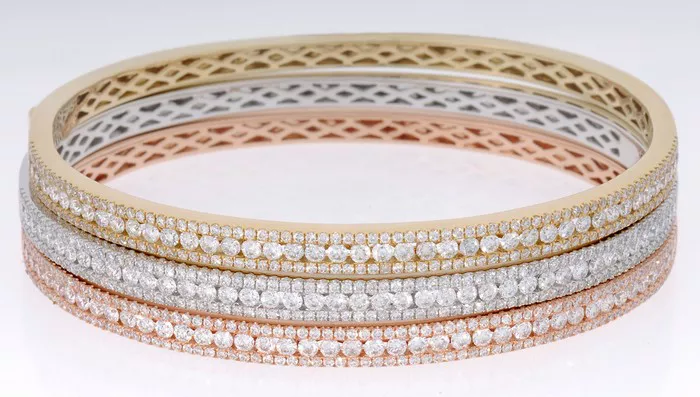The history of jewelry is often as fascinating as the pieces themselves, with each accessory carrying its own tale of inception and evolution. Among the myriad of adornments, the tennis bracelet stands out as an iconic symbol of elegance and sophistication. But who can lay claim to its invention, and what is the story behind its name? Delving into the annals of jewelry history unveils a captivating narrative, weaving together elements of design, celebrity influence, and sporting events.
The Birth of a Classic: Tracing the Origins
To unearth the origins of the tennis bracelet, one must journey back to the late 20th century. Contrary to popular belief, the creation of the tennis bracelet was not attributed to a single individual but rather emerged as a collective evolution in jewelry design.
In the 1970s, there was a surge in popularity for delicate, diamond-studded bracelets characterized by a continuous row of stones set in precious metal. However, it was not until the 1980s that the tennis bracelet gained widespread recognition and acclaim. The catalyst for its rise to prominence? An electrifying display of skill and sportsmanship on the tennis court.
The Spark: From Court to Catwalk
The tennis bracelet owes its moniker to an unforgettable moment in sporting history, which occurred during the 1987 U.S. Open. Renowned tennis champion Chris Evert, known for her grace and finesse on the court, was in the midst of a heated match when a pivotal incident occurred.
As Evert engaged in a fierce rally, her diamond bracelet, an exquisite strand of sparkling gems, snapped loose from her wrist, scattering diamonds across the court. Unfazed by the distraction, Evert calmly requested a brief pause to retrieve her fallen jewelry. This incident, captured by television cameras and witnessed by millions, captivated audiences around the world.
In the aftermath of the match, the incident sparked a newfound fascination with the delicate, diamond-adorned bracelet. Evert’s grace under pressure and the dazzling spectacle of diamonds against the backdrop of a tennis court left an indelible mark on popular culture. Subsequently, the term “tennis bracelet” was coined, forever linking the accessory to the world of professional tennis and its illustrious players.
Evolution of Design: From Classic to Contemporary
While the tennis bracelet may have gained prominence through its association with sports, its enduring appeal transcends athletic arenas. Over the decades, the design of the tennis bracelet has evolved to encompass a myriad of variations, catering to diverse tastes and preferences.
Initially crafted exclusively with diamonds, modern iterations of the tennis bracelet feature an array of gemstones, including sapphires, rubies, and emeralds. Moreover, advancements in jewelry-making techniques have enabled designers to experiment with innovative settings and configurations, resulting in an endless array of styles and designs.
From classic, understated elegance to bold, statement-making pieces, the tennis bracelet continues to captivate jewelry enthusiasts across the globe. Whether worn as a standalone accessory or paired with complementary pieces, its timeless allure endures through the ages.
Cultural Significance: Beyond Fashion and Function
Beyond its aesthetic appeal, the tennis bracelet holds profound cultural significance, symbolizing achievement, elegance, and sophistication. As a staple accessory in both formal and casual settings, it serves as a tangible reminder of life’s special moments and milestones.
For many, receiving a tennis bracelet represents a gesture of love, admiration, or celebration. Whether gifted to commemorate a significant anniversary, milestone birthday, or career achievement, the tennis bracelet serves as a cherished keepsake, imbued with sentiment and meaning.
Moreover, the tennis bracelet has emerged as a symbol of empowerment for women, serving as a tangible expression of success, independence, and self-assurance. As women continue to break barriers and redefine societal norms, the tennis bracelet remains a steadfast companion, symbolizing resilience, determination, and grace.
Conclusion
In conclusion, the invention of the tennis bracelet is a testament to the intersection of art, culture, and craftsmanship. While its origins may be shrouded in legend and lore, its enduring legacy continues to captivate and inspire. From its humble beginnings on the tennis court to its status as a coveted fashion accessory, the tennis bracelet stands as a timeless icon of elegance, sophistication, and style. Whether worn as a symbol of love, achievement, or simply as an expression of personal style, the tennis bracelet remains a cherished adornment, destined to sparkle for generations to come.
FAQs
What does a tennis bracelet symbolize?
A tennis bracelet is a classic piece of jewelry symbolizing elegance, sophistication, and timeless beauty. Its design, featuring a continuous line of diamonds or gemstones, represents eternal love and commitment. The bracelet’s sleek and understated appearance makes it a versatile accessory suitable for any occasion, from casual outings to formal events.
What was a tennis bracelet called before 1987?
Before 1987, tennis bracelets were commonly referred to as “eternity bracelets” or “line bracelets.” The name “tennis bracelet” gained popularity after an incident involving professional tennis player Chris Evert during the 1987 U.S. Open, where she lost her diamond bracelet on the court and requested a pause in the match to search for it.
Is it OK to wear a tennis bracelet every day?
While tennis bracelets are durable and designed for everyday wear, it’s essential to consider your lifestyle and activities. With proper care, including regular cleaning and maintenance, wearing a tennis bracelet daily should not pose any issues. However, it’s advisable to remove it during activities that may subject it to excessive stress or damage.
Who is the tennis bracelet named after?
The tennis bracelet is named after renowned American tennis player Chris Evert. During the 1987 U.S. Open, Evert’s diamond bracelet, which she wore during matches, accidentally fell off her wrist. She requested a halt in the match until the bracelet was found, bringing significant attention to the piece of jewelry and popularizing it as the “tennis bracelet.”

